
Your total lawn care cost depends on several factors, including the type of service and lawn size. Our guide will cover what you can expect to pay for lawn care.
Not every mushrooms is as innocent as it looks


Some mushrooms are harmless, while others are dangerous.
Knowing how to identify them will help you know what steps to take next.
Mushrooms grow due to excess moisture, rotting wood, a shaded yard, and compacted soil.
Ringless honey and meadow mushrooms are some of the most commonly found in yards.
You can prevent mushrooms from growing by eliminating shade, removing rotting wood, and putting drainage measures in place to eliminate excess moisture.
Knowing what's growing on your lawn is smart whether you’re interested in backyard biodiversity or have kids and pets running around. Many lawn mushroom types commonly sprout in yards, especially during rainy seasons. While some mushrooms are harmless (and even play a huge role in local ecologies), others are downright deadly. It’s important to know what common mushrooms are safe to keep around and which ones to remove ASAP.
Kids see mushrooms as magical toadstools for gnomes and fairies. Adult homeowners (and renters) see them as potentially deadly nuisances. They can be either good or bad, depending on the mushroom type.
Hat-like shrooms you see popping their heads out from your grass are just the fruiting portions of the fungus. As the reproductive portion of the mushroom, the head's purpose is to scatter spores around your yard with help from the wind. The rest of the mushroom stays firmly underground, breaking up dead material in your lawn. The nutrients from this broken-down material become food for your grass.
When taking on this project, expect questions only a pro can answer. With our network of local pros, you'll get the job done and your questions answered—without the hassle and stress of doing it yourself.
Different factors can cause your yard to turn into a mushroom field. First, yards with high organic content are mushroom magnets. That's because mushrooms see your yard as a smorgasbord of nutrition if your soil is bursting with organic content.
An abundant mushroom city on your lawn isn't necessarily a sign of something wrong. In fact, having lots of mushrooms is a sign that your soil is healthy and alive. However, poisonous mushrooms create cause for concern. Take a look at the most common reasons why your yard has mushrooms.
Mushrooms adore damp, shady yards. You'll often find them growing outwardly from an epicenter of soggy, soft brush. Trim your tree branches to let in the sunlight to address the mushrooms in your lawn.
An uptick in mushroom proliferation is often a sign there's rotting wood in your yard. That usually means old tree roots and stumps. Balancing the wood content in your soil with leafy greens can be a way to fix this issue. Removing old tree stumps is one solution, and mulching with greens is another.
How can you tell if your soil is compacted? The telltale sign is standing water that remains on your lawn long after rain has come and gone. Perpetually damp soil is often compacted soil. To increase drainage, lawn aeration may be necessary.
If you're suddenly experiencing an onslaught of mushrooms in your yard this year, the issue may have started in the sky instead of the ground. Mushrooms tend to form after heavy rains, so they may have sprouted due to a perfect storm of rainy, cloudy weather that gave them time to bloom. Once it’s dry, they’ll disappear on their own.
Being overzealous in growing new grass has caused mushroom growth. Try watering your lawn just enough to keep your grass healthy without creating a wet environment to attract fungi.
Check out these 12 types of mushrooms frequently found in yards.
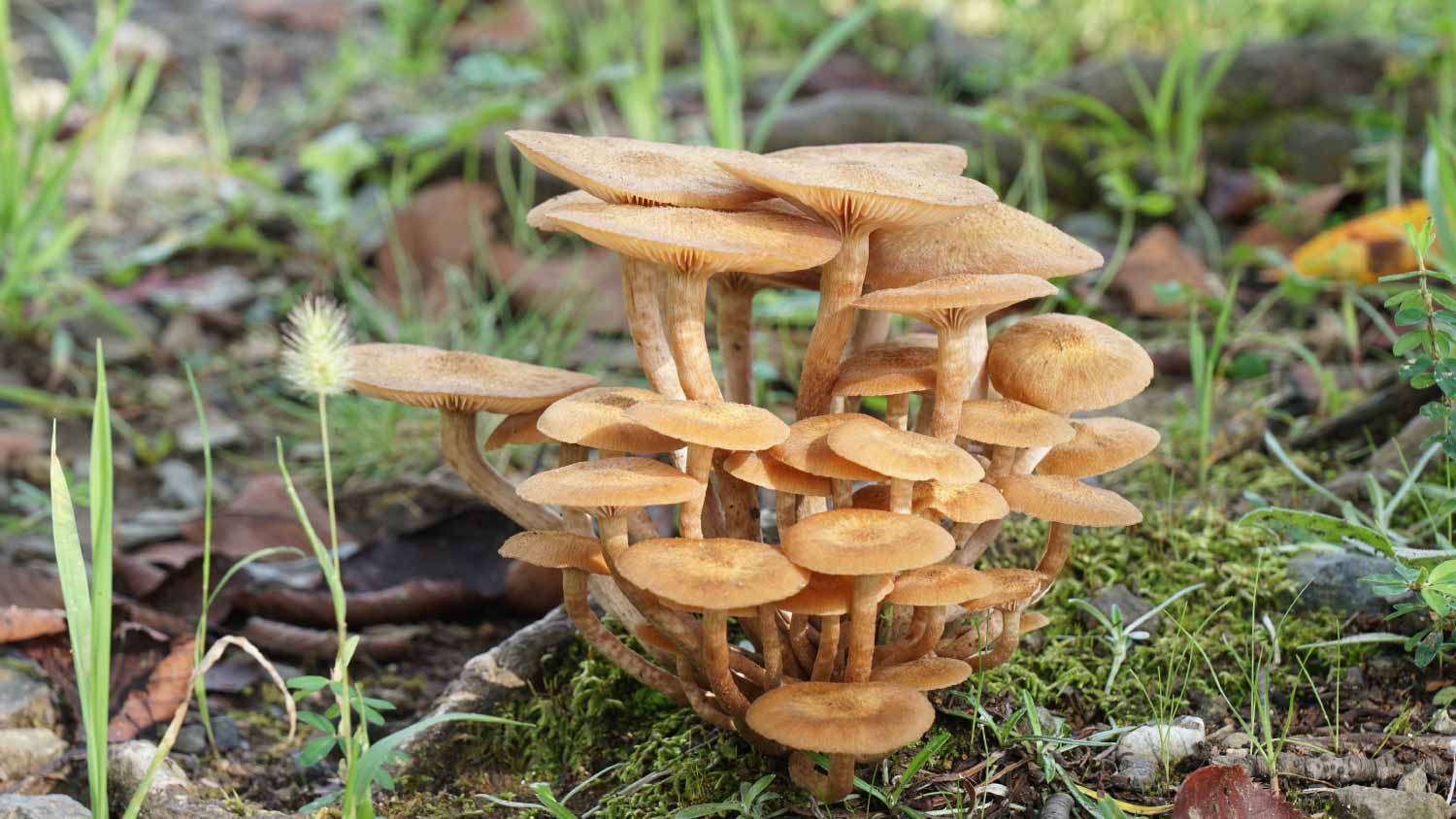
In your yard, you might come across ringless honey mushrooms growing on tree stumps or tree trunks, particularly oak trees. As the name suggests, these mushrooms have a golden cap that is the color of honey, and you’ll usually find these growing from September to November.
While fungi can play an important role in ecosystems, get rid of these mushrooms if they appear in your yard. Ringless honey mushrooms can kill trees by preventing them from receiving water and nutrients.
Scientific name: Desarmillaria caespitosa, formerly Armillaria tabescens
Size: These mushrooms grow 2 to 8 inches tall and 1 to 4 inches wide.
Location: Eastern United States
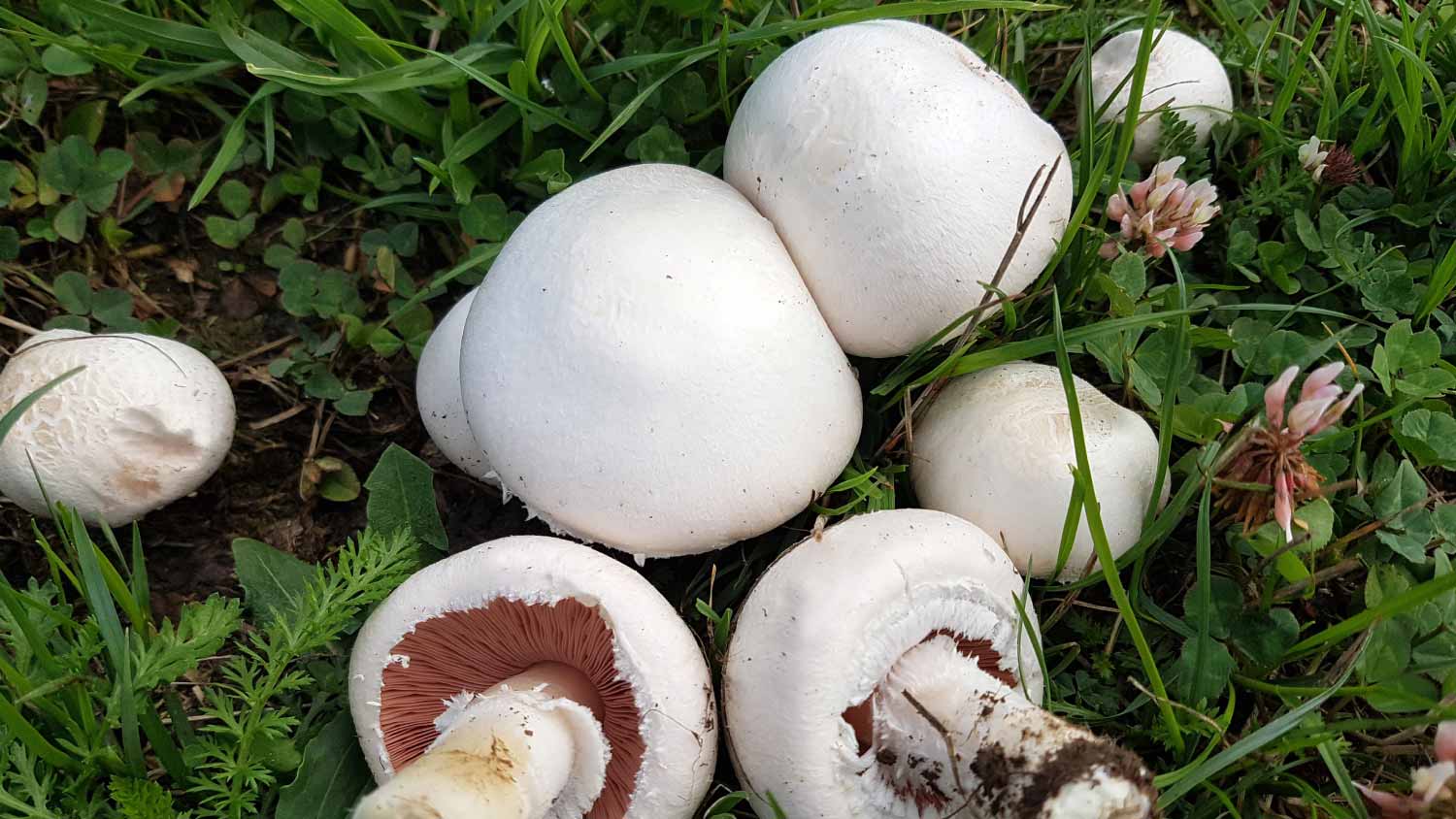
You'll find these mushrooms in backyards despite being known as meadow or field mushrooms. They have white or gray-brown caps with pink or brown gills underneath and grow amid the grass during the summer. While harmless, they resemble a deadly mushroom we’ll discuss later, so be sure to keep kids and pets away if you’re unsure which one it is.
Scientific name: Agaricus campestris
Size: Meadow mushrooms are short, about 1 to 2 inches, and the caps grow 1 to 4 inches wide.
Location: North America and parts of Asia, Europe, New Zealand, and northern Africa

It’s a mushroom by many names: the haymaker’s, mower’s, lawn mowers, or brown hay mushroom. This little brown mushroom is common in yards across North America and Europe, and although it’s not poisonous, it is inedible, so keep kids and pets away. Surprisingly, these mushrooms prefer frequently mowed lawns and can quickly take over your property.
Scientific name: Panaeolus foenisecii
Size: These mushrooms are about 1 to 3 inches tall with caps less than 1.5 inches wide.
Location: North America (particularly the Pacific Northwest) and Europe.

Known also as shaggy mane or shaggy ink cap, the lawyer’s wig mushroom will stand tall among blades of grass. It starts as a long, white mushroom but quickly shrivels from the bottom up and turns inky black when picked or ready to release its spores.
This type of mushroom is not poisonous, so they don’t immediately threaten you or your pets if consumed. However, if you want to get rid of them, you’ll need to remove their food source, trim branches above their growing area to increase sunlight, and aerate your lawn for added drainage.
Scientific name: Coprinus comatus
Size: Lawyer’s wig mushrooms grow 2 to 8 inches tall and about 2 inches wide.
Location: North America and Europe

The aptly named puffball mushrooms are several different types of ’shrooms, including the giant puffballs, which can grow up to two feet wide. If you step on the smaller varieties in your lawn, they will release brown spores. These unique mushrooms don’t have gills or stems and are non-poisonous, so you’re safe to add them to your meals so long as the flesh is white when you cut into them.
Scientific name: Multiple
Size: Puffball sizes vary by species, but this mushroom can grow up to 2 feet wide.
Location: Globally in temperate climates
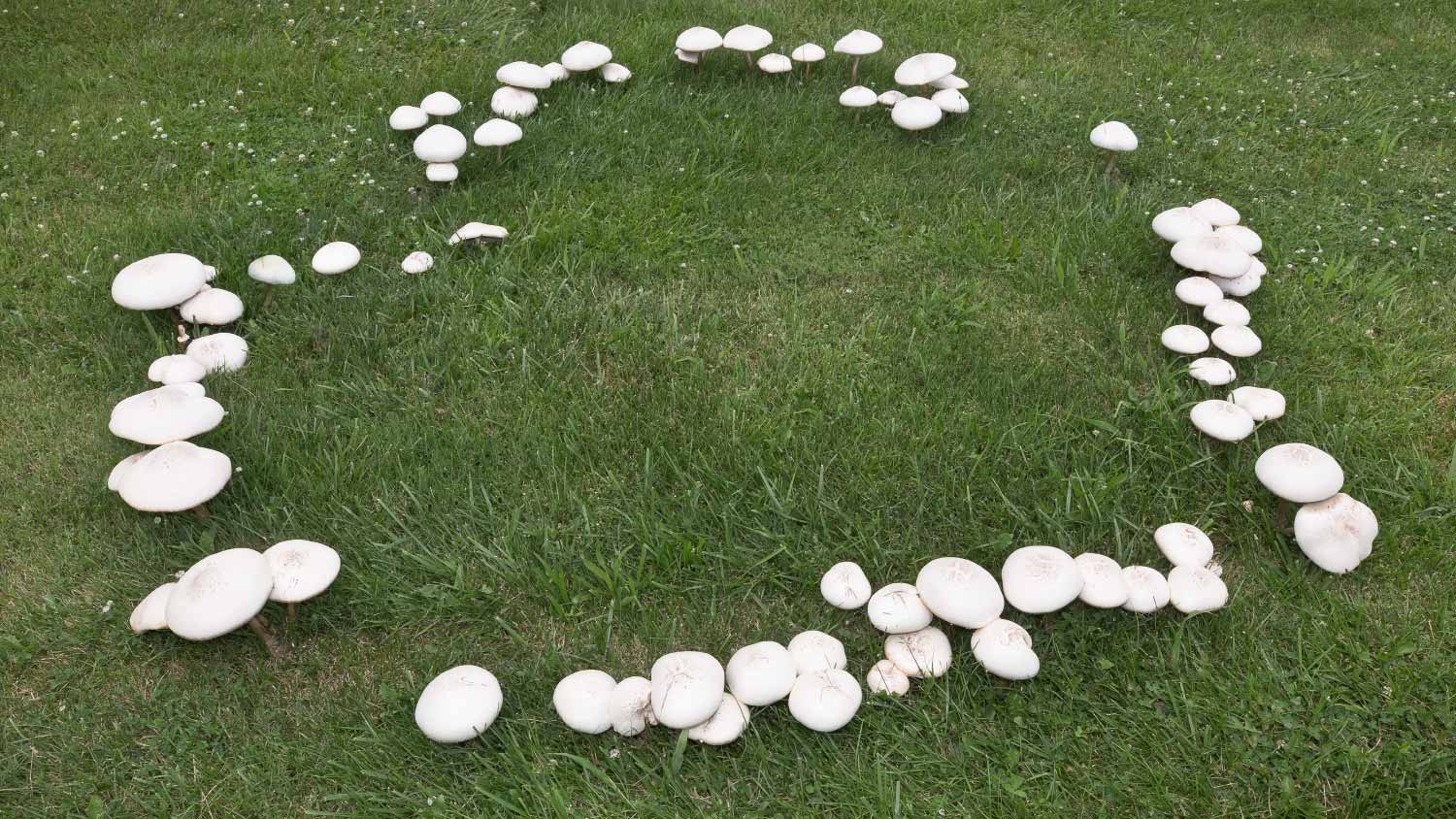
Fairy rings are a common lawn problem or magical experience, depending on your perspective. These rings of mushrooms pop up in lawns that are moist and rich in nutrients. They’re also non-poisonous, so they won’t cause any harm to those who encounter them. While fairy rings can consist of dozens of different mushrooms, fairy ring mushrooms (Marasmius oreades) are a common species in this phenomenon.
Scientific name: Marasmius oreades
Size: This species grows about 0.75 to 3 inches tall and 0.4 to 2 inches tall. Fairy rings, the circles taking over your lawn, can span up to 15 feet in diameter.
Location: North America and Europe
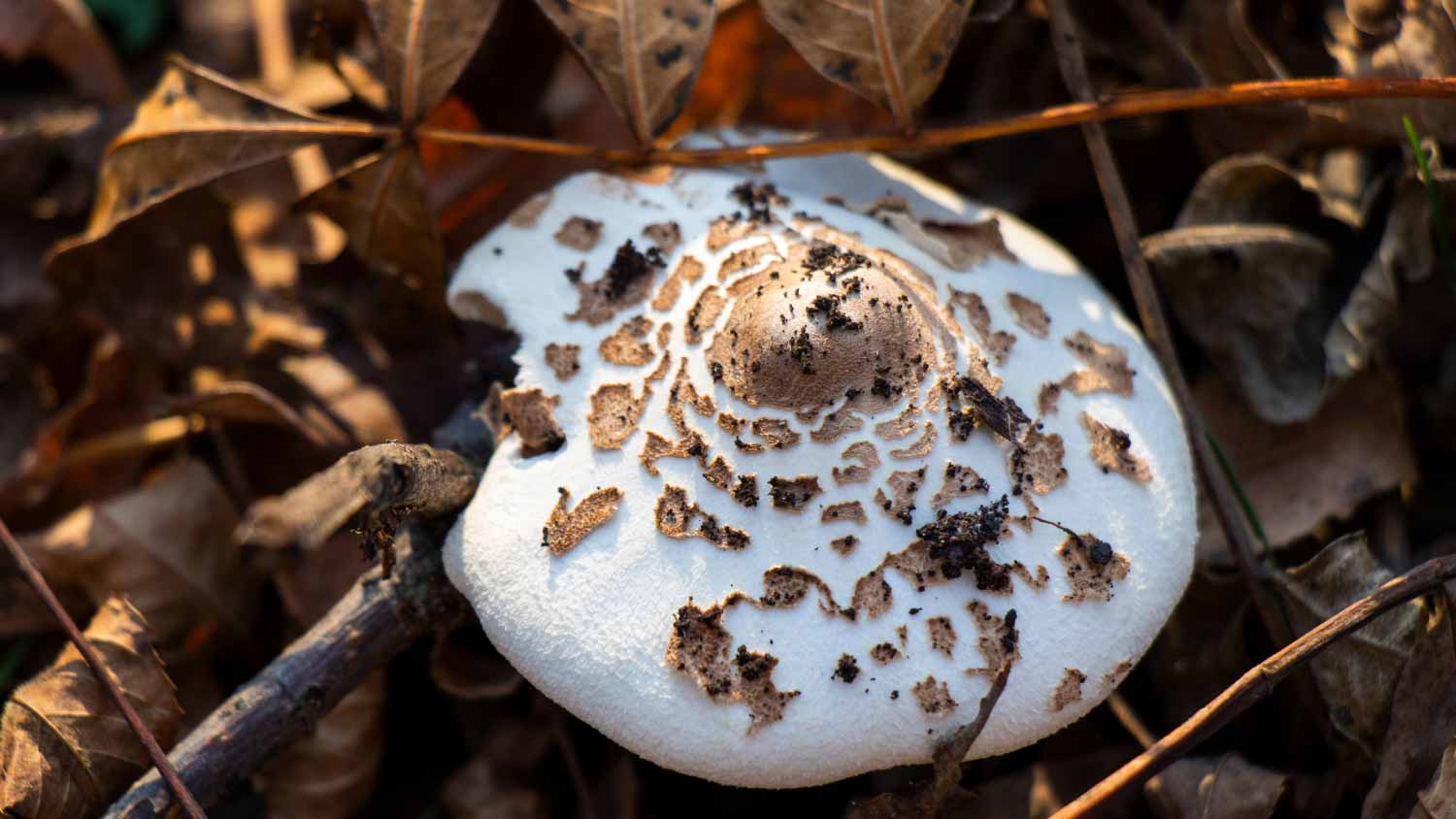
According to a 2018 study, there are about 7,400 cases of mushroom poisoning in the U.S. per year, many of which are related to the widespread vomiter mushroom, also called false parasol or green-spored parasol. It’s often confused for a lawyer’s wig mushroom, but true to its name, this mushroom will make you vomit excessively if ingested. Keep an eye out for its green spores, and do not let kids or pets eat these mushrooms.
Scientific name: Chlorophyllum molybdites
Size: Caps may be 2 to 12 inches wide, and the mushrooms may grow 2 to 10 inches tall.
Location: North America

If you see a tall, bright-white mushroom in your yard, usually around oak trees, destroy it ASAP. Destroying angels, or death angels, are incredibly poisonous mushrooms that you need to remove if kids or pets run around your lawn. After removing these often deadly mushrooms, you will need to fertilize and aerate the lawn to prevent mushroom regrowth.
Scientific name: Amanita bisporigera
Size: This mushroom can grow 4 to 10 inches tall and 1 to 5.5 inches wide.
Location: Eastern regions of North America and Europe

With a name that won't have it winning a popularity contest anytime soon, the common stinkhorn is a mushroom that's a common sight in forested yards and mulched gardens. This mushroom is infamous for its pungent odor that resembles rotted meat. Unfortunately, this smell has been known to attract dogs. It's important to keep pets away from common stinkhorn mushrooms if you see them growing in your yard because they can make pets sick.
Scientific name: Phallus impudicus
Size: A mature common stinkhorn mushroom can grow to between 3.9 inches 11.8 inches in height. Caps grow to reach 1.6 inches.
Location: Europe and North America, especially around the Gulf Coast
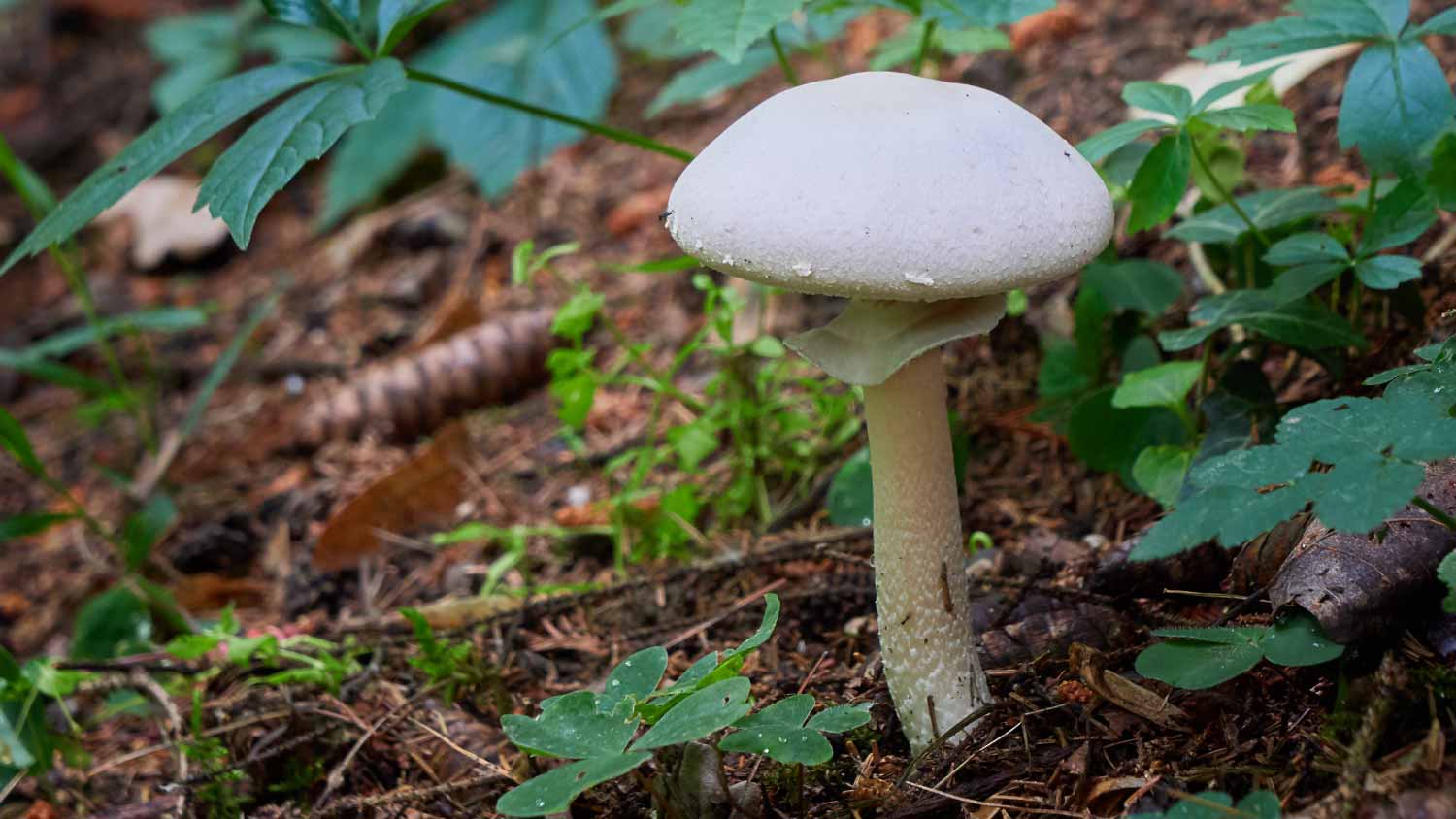
Commonly found around stables and meadows, horse mushrooms resemble white orbs. Many people describe the odor of horse mushrooms as being like anise. Foragers favor these non-poisonous mushrooms due to their large size and pleasant flavor. It’s safe to say if you, your pets, or any of your loved ones come across horse mushrooms in your yard, they’re fine to keep around and even snack on once washed.
Scientific name: Agaricus arvensis
Size: While horse mushroom stalks can reach 2 inches to 5 inches, caps can grow to span from 2.8 inches to just under 8 inches.
Location: Great Britain, the United States, and parts of Asia

The name of these mushrooms says it all. Their scientific name means "deadly poisonous." Featuring a stem with a skirt-like ring, these mushrooms are often easily recognizable due to their pungent odor. When accidentally consumed, their highly poisonous effects on the liver can take up to 14 hours to manifest. Keep a safe distance if you spot them in your yard.
Scientific name: Amanita phalloides
Size: These deadly mushrooms are between 1.5 inches and 7 inches tall. Caps often span 2 inches to 5 inches across.
Location: United States and Europe

Also known as the yellow fieldcap mushroom, this slick and tiny non-poisonous mushroom varies in color between yellow and green. Their rounded tops can make these mushrooms appear like colored marbles in your yard from a distance. You're likelier to see these mushrooms if you have a heavily composted yard.
Scientific name: Bolbitius titubans
Size: With heights ranging from just 1 inch to 5 inches, it's rare for a patch of these mushrooms to look uniform. Cap width generally maxes out at just under 3 inches.
Location: Britain, Ireland, parts of mainland Europe, and the United States
Mushrooms love wet, shaded areas. If you want to eliminate mushrooms in your yard, create the opposite environment. Let’s go over some ways to make your yard inhospitable to common lawn mushrooms.
Remove trees that create shade around your home.
Remove rotting wood and tree stumps from your yard.
Address drainage issues that cause your yard to remain damp.
Hire a pro to aerate your yard. Aeration is a process that creates holes in your soil to allow air and water to enter the grass root.
Hire a local lawn care service to professionally dethatch your grass. Dethatching removes the layer of grass, roots, stems, and crowns between your grass and soil that could be feeding mushrooms.
Paige Bennett contributed to this piece.
From average costs to expert advice, get all the answers you need to get your job done.

Your total lawn care cost depends on several factors, including the type of service and lawn size. Our guide will cover what you can expect to pay for lawn care.

Removing an old lawn is often necessary to plant new grass or build a new outdoor structure. Find out what to budget for your lawn removal cost.

The cost to reseed a lawn can vary depending on the size of your yard and the condition of the soil. We’ll help you figure out the true cost of reseeding or overseeding your lawn, along with whether or not you should hire a professional.

Don’t let your grass clippings go to waste. Instead, turn them into mulch or add them to your compost pile. These tips and more are included in our helpful guide.

Dreaming of a lush lawn but don’t want to wait for seed to grow? Use these sod questions to prep yourself for an easy and stress-free installation.
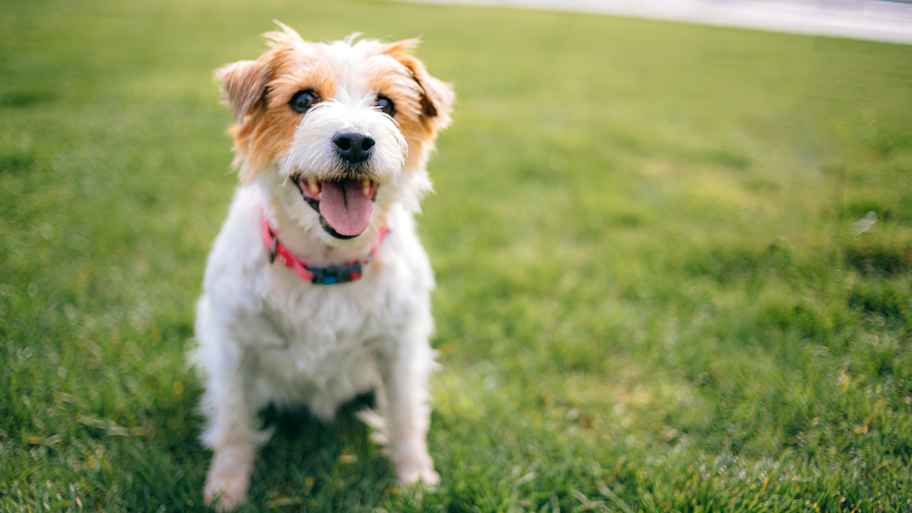
Spot common warning signs of too much nitrogen in the lawn and learn how to fix damage from overfertilizing or pet urine to keep grass green and healthy.